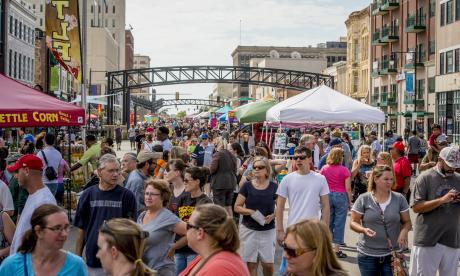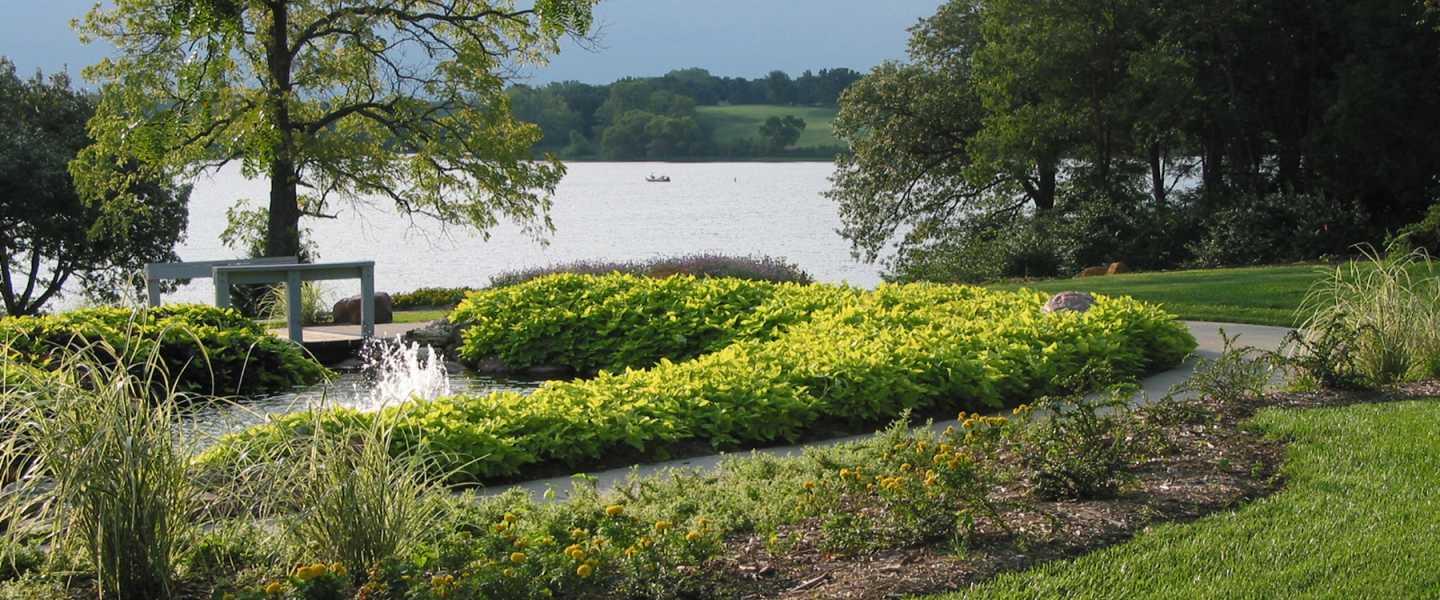Neighborhood Guide
Get a feel for one of Topeka’s unique and historic neighborhoods. Take a cruise or enjoy a walk today.
Potwin Place
This area is known for its big, Victorian-style homes and circular intersections. Potwin is a community favorite, especially at Christmastime, when neighbors join forces to decorate the homes and intersections with lights and themed décor. It's common to hear carols being sung or even to run into Santa himself during a tour through the neighborhood to see the lights during the holidays. Halloween and Fourth of July also are popular holidays to celebrate in Potwin with decorations, parades and activities.
The Potwin Place Historic District was named for Charles Wolcott Potwin, a banker from Zanesville, Ohio, who purchased 70 acres of land west of Topeka in 1869. When Potwin divided his land into plots and offered them for sale in 1885, he required that any home built on the lot would cost at least $2,000 to build. Potwin’s idea of an exclusive, prosperous development was realized as all of the homes built exceeded the minimum figure, some by a considerable amount. From 1888 through 1899, Potwin Place was recognized as its own city, until annexed into Topeka.
Potwin Place is bound by Broadmoor Avenue on the east, Grove on the north, Woodlawn Avenue on the west and Willow Avenue on the south.
Collins Park
The Collins Park neighborhood has winding roads, big trees and many picturesque English Tudor, Colonial and Cape Cod style homes. A stroll through this area in warm weather and you'll notice residents on their porch swings or dining outdoors. The area is bound by Oakley Avenue on the west, Randolph Avenue on the east, Huntoon Street on the north, and 15th Street on the south. It was developed in the 1920s with about 200 homes. Collins Park itself is a large green-space extending from 15th Street four blocks through the middle of the neighborhood to Huntoon.
Each July the Collins Park neighborhood has a “come-as-you-are” Independence Day parade typically held at 11 a.m. on July 4. This neighborhood parade attracts people from all over the city and children are invited to walk or ride a bike in the festivities. The Collins Park parade is believed to be the city’s longest continuous parade, running more than 40 years. The parade usually starts at SW 15th and Collins and goes around the park. A neighborhood garage sale is typically held in early summer.
College Hill
Located just north of Washburn University’s beautiful campus, College Hill is a historic neighborhood with a mixture of American Four-square, Victorian, Georgian Revival and Craftsman homes. College Hill is home to some of Topeka’s favorite local restaurants and businesses near Washburn Avenue. College Hill is bound by Washburn Avenue on the east, Huntoon Street on the north, MacVicar Avenue on the west and 17th Street on the south.
The College Hill Fourth of July activities include a neighborhood parade, turtle races and other activities and finishes up with free ice cream sandwiches in the Boswell Park. A neighborhood garage sale is typically held in early summer.
Holliday Park
Named after Topeka and Santa Fe Railroad founder Cyrus K. Holliday (1826-1900), the Holliday Park neighborhood centers on a 1.5 acre triangular park at 12th and Western. As Topeka underwent rapid growth through the late 1880s, houses started to fill up the prairie and nearby residents formed the Holliday Park Association to beatify the park.
The surrounding turn-of-the-century neighborhood contains some of the oldest homes in Topeka and boasts of a myriad of distinctive houses from all periods and styles: Italianate, Queen Anne, Colonial Revival, Craftsman, Bungalow, Prairie, Tudor. Here resided (and resides) a diverse community: working class to business executive - bankers, educators, journalists, and more; from railroad treasurer to railroad conductor, widow of an Episcopal Bishop of Kansas to Jewish merchant. Like most older, urban districts, it experienced decline following World War II, but recent years have witnessed a revival as more and more young people (and not so young) restore and repaint their Victorian/Edwardian homes.
The Holliday Park neighborhood is bound by Topeka Boulevard on the east, 9th Street on the north, Buchanan Street on the west and Huntoon Street on the south.
Westboro
Westboro is a central-Topeka neighborhood featuring large homes in Italian Renaissance Revival, French Eclectic and Colonial styles. This area includes a quaint shopping area, Westboro Mart, with an eclectic array of specialty shops.
Many of the homes in Westboro, built in the 1920s and 1930s, became model homes for the L.F. Garlinghouse Company of Topeka, which sold the floor plans via annual catalogs throughout the United States.
The Westboro neighborhood is bound by Huntoon Street on the north, Oakley on the east, 17th Street on the south and Gage Boulevard on the west.
Oakland
The Oakland neighborhood was founded more than 100 years ago by Mexican immigrants who came to Topeka to work with the railroad. Over the decades, the community has grown and prospered, anchored in its Hispanic heritage. The region is home to the Church of Our Lady of Guadalupe. Since 1914 the church has been and continues to be a center and a refuge in times of distress for thousands of immigrants and Mexican Americans in the community and offers services in English and Spanish. The neighborhood is also home to one of the oldest Mexican parties in the country, Fiesta Topeka. The week-long event held every summer features a carnival, live music, a jalapeño eating contest, authentic Mexican food, and much more. Many of Topeka's local restaurants and retailers are located in the Oakland area. Oakland is located in the Topeka Public Schools school district.
Planning a move to Topeka?
- Explore a digital version of the Chamber of Commerce Relocation Guide
- Information for young professionals
- Maps
- Come work here! Apply for a $10,000 grant to move to Topeka >>









